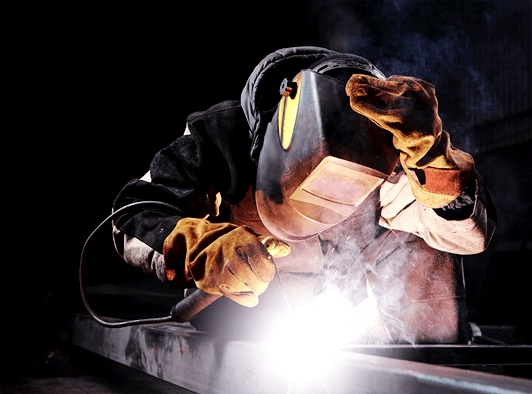Why a Good Welding Helmet is Essential
When it comes to welding, safety should always be a top priority. One of the most important pieces of safety equipment for welders is a good welding helmet. A welding helmet not only protects the eyes and face from harmful UV rays and debris but it also enhances visibility and accuracy during welding.
Welding produces intense light and heat, which can be damaging to the eyes and skin. The UV rays emitted during the welding process can cause serious eye injuries, including burns and long-term damage, such as cataracts. In addition, sparks, spatter, and flying debris can pose a risk to the face and eyes. A good welding helmet provides a barrier between the welder and these hazards, ensuring their safety.
Furthermore, a welding helmet with a clear and unobstructed view is essential for accurate welding. Welders need to be able to see their workpiece clearly in order to make precise welds. A welding helmet with a wide viewing area and a high-quality lens can greatly enhance visibility, allowing welders to see their workpiece in detail and make accurate adjustments as needed.
Types of Welding Helmets: Pros and Cons
There are two main types of welding helmets: passive welding helmets and auto-darkening welding helmets. Each type has its own pros and cons, and it’s important to understand them in order to make an informed decision.
Passive welding helmets are the traditional type of welding helmet. They have a fixed shade lens that is typically a shade of 10 or 11. These helmets are simple and affordable, making them a popular choice for beginner welders or those on a tight budget. However, passive welding helmets have limited visibility and convenience. The fixed shade lens means that the welder has to lift the helmet up every time they need to inspect their work or adjust their position. This can be time-consuming and can increase the risk of eye injuries.
On the other hand, auto-darkening welding helmets are more advanced and offer better visibility and convenience. These helmets have a lens that automatically adjusts its shade level based on the intensity of the light. This means that the welder can keep the helmet down at all times, allowing for continuous protection and uninterrupted work. Auto-darkening welding helmets also have a wider range of shade levels, allowing welders to choose the right level of protection for their specific welding application.
Auto-Darkening vs. Passive Welding Helmets: Which is Better?
When it comes to choosing between auto-darkening and passive welding helmets, there are several factors to consider.
One of the main factors is visibility. Auto-darkening welding helmets offer better visibility compared to passive welding helmets. The ability to keep the helmet down at all times allows for continuous protection and uninterrupted work. The auto-darkening lens also adjusts its shade level automatically, ensuring that the welder always has the right level of protection without having to manually change the lens.
Another factor to consider is convenience. Auto-darkening welding helmets are more convenient to use compared to passive welding helmets. With an auto-darkening helmet, the welder does not have to constantly lift the helmet up to inspect their work or adjust their position. This saves time and reduces the risk of eye injuries. Additionally, auto-darkening helmets often have additional features such as grind mode, which allows the welder to switch between welding and grinding without having to change helmets.
However, it’s important to note that auto-darkening welding helmets are generally more expensive than passive welding helmets. This can be a deterrent for those on a tight budget. Passive welding helmets, on the other hand, are more affordable and can be a good option for beginner welders or those who only weld occasionally.
Lens Shade: Choosing the Right Level of Protection
The lens shade is an important consideration when choosing a welding helmet. The lens shade number indicates the level of darkness of the lens, with higher numbers indicating darker shades. The right lens shade depends on the specific welding application and the intensity of the light.
For most welding applications, a lens shade of 10 or 11 is sufficient. This provides enough protection from the UV rays emitted during welding while still allowing for good visibility. However, for more intense welding processes such as arc welding or plasma cutting, a higher lens shade may be required. A lens shade of 12 or higher can provide the necessary protection for these applications.
It’s important to choose the right lens shade for your specific welding needs in order to ensure adequate protection. Using a lens shade that is too dark can make it difficult to see the workpiece clearly, leading to inaccurate welds. On the other hand, using a lens shade that is too light can expose the eyes to harmful UV rays, increasing the risk of eye injuries.
Factors to consider when choosing the right lens shade include the type of welding process, the intensity of the light, and personal preference. It’s always a good idea to consult the manufacturer’s recommendations and guidelines for the specific welding helmet and lens shade.
Viewing Area: Finding the Right Balance Between Comfort and Visibility
The viewing area of a welding helmet is another important factor to consider when choosing the right helmet. A wide viewing area is essential for better visibility and accuracy during welding.
A larger viewing area allows the welder to see their workpiece in detail, making it easier to make precise welds. It also reduces the need to constantly reposition the helmet in order to see different areas of the workpiece. This can save time and improve efficiency.
However, it’s important to find the right balance between comfort and visibility. A helmet with a very large viewing area may be heavy and bulky, making it uncomfortable to wear for extended periods of time. It’s important to choose a helmet that is comfortable and fits well, as this will ensure that the welder can work for longer periods without discomfort or fatigue.
Factors to consider when choosing the right viewing area include the size of the workpiece, the type of welding process, and personal preference. It’s also important to consider the weight and balance of the helmet, as a heavy helmet can cause strain on the neck and shoulders.
Comfort and Fit: Factors to Consider for Extended Use
Comfort and fit are crucial factors to consider when choosing a welding helmet, especially if you will be using it for extended periods of time. A comfortable and well-fitting helmet can greatly improve the overall welding experience and reduce fatigue.
One of the most important factors to consider is the weight of the helmet. A heavy helmet can cause strain on the neck and shoulders, making it uncomfortable to wear for long periods. Look for a helmet that is lightweight but still offers adequate protection.
The padding and suspension system of the helmet also play a role in comfort and fit. Look for a helmet with adjustable padding and suspension, as this allows for a customized fit. The padding should be soft and comfortable, while the suspension system should provide a secure and stable fit.
It’s also important to consider the size and shape of the helmet. Different helmets are designed to fit different head sizes and shapes. Make sure to choose a helmet that fits snugly but comfortably on your head. A helmet that is too loose or too tight can be uncomfortable and may not provide adequate protection.
Durability and Maintenance: Ensuring Longevity and Performance
Durability and maintenance are important considerations when choosing a welding helmet. A durable helmet is essential for longevity and performance, as it will be able to withstand the rigors of welding and provide reliable protection.
Look for a helmet that is made from high-quality materials that are resistant to heat, sparks, and impact. The helmet should be able to withstand the intense heat and light produced during welding without warping or cracking. It should also be able to withstand sparks and debris without compromising the integrity of the helmet.
Regular maintenance is also important for ensuring the longevity and performance of a welding helmet. Clean the helmet regularly to remove dust, dirt, and debris that can accumulate on the lens and obstruct visibility. Check the helmet for any signs of wear or damage, such as cracks or loose parts, and replace any worn or damaged components.
It’s also a good idea to store the helmet in a cool and dry place when not in use, as excessive heat and moisture can degrade the materials and reduce the lifespan of the helmet. Follow the manufacturer’s guidelines for maintenance and care to ensure that the helmet remains in good condition.
Brand and Price: Balancing Quality and Affordability
When it comes to choosing a welding helmet, it’s important to balance quality and affordability. While it may be tempting to choose a cheaper option, it’s important to invest in a reputable brand that offers high-quality helmets.
A reputable brand is more likely to use high-quality materials and manufacturing processes, ensuring that the helmet is durable and reliable. They are also more likely to have a good customer support system in place, allowing you to get assistance if you encounter any issues with the helmet.
However, this doesn’t mean that you have to break the bank to get a good welding helmet. There are many reputable brands that offer high-quality helmets at affordable prices. Look for helmets that offer a good balance between quality and affordability, and consider factors such as warranty and customer reviews when making your decision.
Additional Features: Considerations for Specific Welding Applications
In addition to the basic features, there are also additional features that can be beneficial for specific welding applications. These features can enhance safety, comfort, and convenience, depending on the specific needs of the welder.
One such feature is respiratory protection. Some welding helmets come with a built-in respiratory system that filters out harmful fumes and particles. This can be especially beneficial for welders who work in confined spaces or in environments with poor ventilation.
Another feature to consider is grind mode. Grind mode allows the welder to switch between welding and grinding without having to change helmets. This can save time and improve efficiency, as the welder does not have to switch between different helmets for different tasks.
Other additional features to consider include adjustable sensitivity and delay settings, which allow the welder to customize the helmet to their specific welding needs. Some helmets also come with a digital display that shows important information such as battery life and shade level.
Making the Right Choice for Your Welding Needs
In conclusion, choosing the right welding helmet is essential for safety, visibility, and accuracy during welding. There are several factors to consider when making your decision, including the type of helmet, lens shade, viewing area, comfort and fit, durability and maintenance, brand and price, and additional features.
It’s important to choose a helmet that provides adequate protection from harmful UV rays and debris, while also offering good visibility and convenience. Consider factors such as the type of welding process, the intensity of the light, and personal preference when choosing the right lens shade and viewing area.
Comfort and fit are crucial for extended use, so choose a helmet that is lightweight, well-padded, and has an adjustable suspension system. Durability and maintenance are also important for ensuring longevity and performance, so choose a helmet that is made from high-quality materials and follow the manufacturer’s guidelines for maintenance and care.
Finally, balance quality and affordability by choosing a reputable brand that offers high-quality helmets at affordable prices. Consider additional features that may be beneficial for your specific welding application, such as respiratory protection or grind mode.
By considering all these factors, you can make the right choice for your specific welding needs and ensure a safe and successful welding experience.








